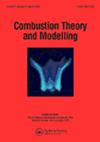Reduced kinetic mechanism for methane/oxygen rocket engine applications: a reliable and numerically efficient methodology
IF 1.6
4区 工程技术
Q4 ENERGY & FUELS
引用次数: 0
Abstract
CFD simulations of turbulent reacting flows based on finite rate chemistry often employ reduced kinetic mechanisms to decrease the computational cost, especially if the combustion of hydrocarbons is involved. This work presents a chemical-kinetic methodology, consisting of the formulation, development, testing and validation of a reduced, skeletal mechanism targeted to the Liquid Rocket Engines (LRE) combustion of CH4/O2. The reduced mechanism is generated for combustion processes involving medium-high pressures and ignition of undiluted methane-oxygen, using the 0D/1D open-source software Cantera. The presented mechanism, named Medium Pressure Rocket Burn (MPRB), is achieved from a semi-detailed kinetic scheme, i.e. Lu30, derived from the detailed mechanism GRI-Mech 3.0. Identification of the main chemical reaction paths and sensitivity analysis applied in a sequence leading to a final scheme consisting of 19 species and 51 reactions. Promising results are obtained in terms of ignition delay times and comparison with experimental measurements in high-pressure shock tube tests. The validation is extended to the turbulent case using a sub-scale single-injector combustion chamber with a gaseous injection of CH4/O2 as a benchmark. First, Improved Delayed Detached Eddy Simulations (IDDES) based on a non-adiabatic flamelet database are in good agreement with the available experimental data, although the average thermal load foreseen by MPRB is about 12.6% higher than the case with Lu30 used as reference. Secondly, RANS simulations based on the Eddy Dissipation Concept (EDC) show that accurate results can be obtained with an affordable computational cost, compared to the previously investigated detailed chemistry calculations. Overall the successful validation of the presented reduced mechanism encourages its use for CH4/O2 combustion regimes within this range of applicability.甲烷/氧火箭发动机应用的减少动力学机制:一种可靠和数值上有效的方法
基于有限速率化学的湍流反应流CFD模拟通常采用简化的动力学机制来降低计算成本,尤其是在涉及碳氢化合物燃烧的情况下。这项工作提出了一种化学动力学方法,包括针对液体火箭发动机(LRE)CH4/O2燃烧的简化骨架机制的配方、开发、测试和验证。还原机理是使用0D/1D开源软件Cantera为涉及中高压和未稀释甲烷氧点火的燃烧过程生成的。所提出的机制,命名为中压火箭燃烧(MPRB),是从半详细的动力学方案,即Lu30实现的,该方案源自详细的机制GRI-Mech 3.0。主要化学反应路径的识别和灵敏度分析按顺序应用,最终形成由19个物种和51个反应组成的方案。在点火延迟时间方面以及与高压冲击管试验中的实验测量结果的比较方面,获得了有希望的结果。验证扩展到湍流情况,使用以CH4/O2气体喷射为基准的小规模单喷射器燃烧室。首先,基于非绝热小火焰数据库的改进延迟分离涡流模拟(IDDES)与可用的实验数据非常一致,尽管MPRB预测的平均热负荷比使用Lu30作为参考的情况高出约12.6%。其次,基于涡流耗散概念(EDC)的RANS模拟表明,与之前研究的详细化学计算相比,可以以负担得起的计算成本获得准确的结果。总体而言,所提出的还原机理的成功验证鼓励其在该适用范围内用于CH4/O2燃烧状态。
本文章由计算机程序翻译,如有差异,请以英文原文为准。
求助全文
约1分钟内获得全文
求助全文
来源期刊

Combustion Theory and Modelling
工程技术-工程:化工
CiteScore
3.00
自引率
7.70%
发文量
38
审稿时长
6 months
期刊介绍:
Combustion Theory and Modelling is a leading international journal devoted to the application of mathematical modelling, numerical simulation and experimental techniques to the study of combustion. Articles can cover a wide range of topics, such as: premixed laminar flames, laminar diffusion flames, turbulent combustion, fires, chemical kinetics, pollutant formation, microgravity, materials synthesis, chemical vapour deposition, catalysis, droplet and spray combustion, detonation dynamics, thermal explosions, ignition, energetic materials and propellants, burners and engine combustion. A diverse spectrum of mathematical methods may also be used, including large scale numerical simulation, hybrid computational schemes, front tracking, adaptive mesh refinement, optimized parallel computation, asymptotic methods and singular perturbation techniques, bifurcation theory, optimization methods, dynamical systems theory, cellular automata and discrete methods and probabilistic and statistical methods. Experimental studies that employ intrusive or nonintrusive diagnostics and are published in the Journal should be closely related to theoretical issues, by highlighting fundamental theoretical questions or by providing a sound basis for comparison with theory.
 求助内容:
求助内容: 应助结果提醒方式:
应助结果提醒方式:


